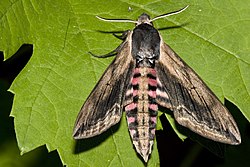- Sphinx chishimensisMatsumura, 1929
- Sphinx spiraeaeEsper, 1800
- Sphinx ligustri albescensTutt, 1904
- Sphinx ligustri amurensisOberthür, 1886
- Sphinx ligustri brunneaTutt, 1904
- Sphinx ligustri brunnescens(Lempke, 1959)
- Sphinx ligustri cingulata(Lempke, 1964)
- Sphinx ligustri eichleriEitschberger, Danner & Surholt, 1992
- Sphinx ligustri fraxiniDannehl, 1925
- Sphinx ligustri grisea(Closs, 1917)
- Sphinx ligustri incertaTutt, 1904
- Sphinx ligustri intermediaTutt, 1904
- Sphinx ligustri lutescensTutt, 1904
- Sphinx ligustri nisseniRothschild & Jordan, 1916
- Sphinx ligustri obscuraTutt, 1904
- Sphinx ligustri pallidaTutt, 1904
- Sphinx ligustri perversaGehlen, 1928
- Sphinx ligustri postrufescens(Lempke, 1959)
- Sphinx ligustri rosaceaRebel, 1910
- Sphinx ligustri seydeliDebauche, 1934
- Sphinx ligustri subpallidaTutt, 1904
- Sphinx ligustri typicaTutt, 1904
- Sphinx ligustri unifasciataGschwandner, 1912
- Sphinx ligustri weryiRungs, 1977
- Sphinx ligustri zolotuhiniEitschberger & Lukhtanov, 1996
|








